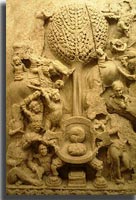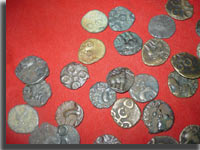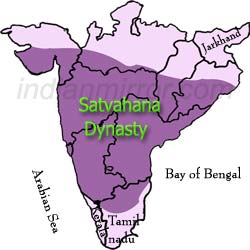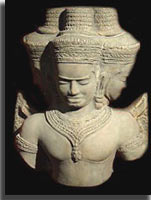History :
Satavahanas were referred as Andhras or the Andhra Dynasty.The Empire was established in the 3rd Centure BC in the western Deccan Plateau. Aitareya Brahmana claims Andhras as the exiled and degenerated sons of Viswamitra. Ashoka's inscriptions mention the Andhras as border people and as Dravidian people who lived between the Godavari and the Krishna. The names of Satavahanas Rulers had emerged from Andhra Pradesh or delta areas of Krishna and Godavari River. Though there were many principalities on the delta of Godavari and Krishna River during Chandragupta Mauryan time , Simukha was the king to unify them into a single kingdom in the 3rd century BC and became the founder of Satavahana dynasty. He laid the foundation in 235 BC and ruled for 23 years.
Kanha (212 - 195 BC) was the successor of Simukha who extended the territory as far as Nasik. Later Satakarni-I probably a son of Kunala became the next king. Though he ruled for only two years, he achieved a lot by conquering Western Malwa, and even performed Asvamedha and Rajasuya Yaga. After Satakarni-I his next succesors were his two minor sons Vedistri and Satisiri who with the help of their mother Nayanika ruled the kingdom.


Sri Yana succeeded the throne in 160 AD and ruled up to 189 AD. His abundant coins bearing the legend Sri-Yana explains prosperity of the empire. But at the end of his regime, Abhiras broke the unity of the Deccan by taking the region around Nasik.
The next king of Satavahana Dynasty, Madhariputra Svami Sakasena succeeded Sri Yana. Minting coins bearing lions and elephant motif on it was done by him. With him ended the age of the great Satavahanas and by the end of the 2nd century A.D., the rule of the Satavahanas became a history of the past.

Place |
Karnataka, Andhra, Gujarat, Maharasthra |
Period |
50 B.C. to 250 A.D |
Language |
Telugu, Maharashtri |
Religion |
Buddhism Vedic/Hinduism |
Empire |
Simuka, Satakarni, Kanva suzerainty |
Administration
The Satavahana Empires society reflected the existence of four classes. The first class was the people who controlled and administered the districts, second were the officials. Third were the Vaidhya, cultivators and fourth class were common citizens. The head of the family was the Grihapati.Both Buddhism and Brahmanism prevailed during the Satavahana rule. Among the various sects of people state of religious tolarence existed following varied faiths.
During Satavahana Dynasty trade flourished and even organisation of workers doing various trades existed like Broach, Sopara and Kalyan the important trade points. The Satavahana rulers patronised Prakrit which was the common language used on documents. Satavahana Empire is said to be partitioned into five provinces. The western territory of Nasik was possessed by the Abhiras. The Ikshavakus dominated over the eastern part in the Krishna -Guntur region.The Chutus possessed the southwestern parts and extended their territory to the north and east. The south eastern parts were under the Pahalvas.
Important aspects of Satavahanas

- Satavahanans issued lead coins (apart from copper and bronze).
- They acted as a bridge between North and South India.
- Satavahana rulers called themselves Brahmans and performed Vedic rituals ,worshipped gods like Krishna, Vasudeva and others. They even promoted Buddhism by granting land to the monks.
- During the Satavahana Empire the two common religious constructions were the Buddhist temple that was called 'Chaitya' & the monasteries called 'Vihara'. The most famous Chaitya is that of Karle in W. Deccan.
- They called the districts as Ahara', as it was in Ashoka's time. And the officials were known as 'amatyas' and 'mahamatras', as they were known in Mauryan times.
- Satavahana Rulers started the practice of granting tax free villages to brahmanas & Buddhist monks.
- The official language of the Dynasty was Prakrit & the script was Brahmi, as in Ashokan times. One Prakrit text called Gathasattasai is attributed to a Satavahana king called Hala.


